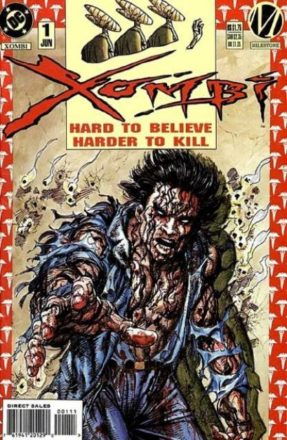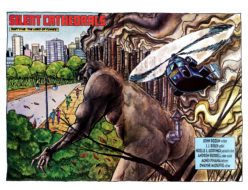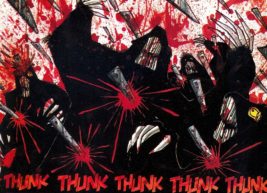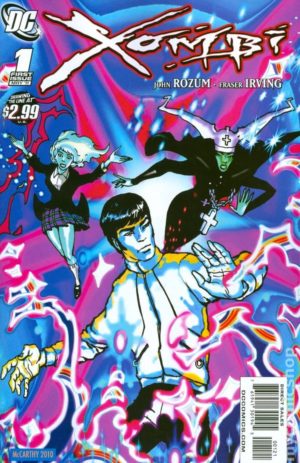 The nineties were a banner era for weird media, comic books in particular. It was then, you’ll recall, that we got SANDMAN vol. 2, SHADE THE CHANGING MAN vol. 2, the Garth Ennis run of HELLBLAZER, PREACHER, KID ETERNITY, THE INVISIBLES and the inception of the DC imprint Vertigo, through which all those titles were issued. One (very) weird comic book saga of the era not published by Vertigo was XOMBI, which was as crazed as any of those other titles but issued through the DC owned Milestone Media.
The nineties were a banner era for weird media, comic books in particular. It was then, you’ll recall, that we got SANDMAN vol. 2, SHADE THE CHANGING MAN vol. 2, the Garth Ennis run of HELLBLAZER, PREACHER, KID ETERNITY, THE INVISIBLES and the inception of the DC imprint Vertigo, through which all those titles were issued. One (very) weird comic book saga of the era not published by Vertigo was XOMBI, which was as crazed as any of those other titles but issued through the DC owned Milestone Media.
Milestone was founded to showcase the work of minority writers and artists. XOMBI is something of an anomaly in the Milestone lineup due to the fact that its writer John Rozum didn’t seem too interested in minority issues, and also its sheer weirdness. It was initially part of the “Dakota Universe” in which Milestone’s early titles were all set, but XOMBI quickly grew beyond the Dakotaverse to inhabit its own bizarre sphere. Beginning in January of 1994, it lasted a scant 22 issues (actually 21, preceded by an “issue 0”), ending in February 1996, amid Milestone’s purge of its slower-selling titles (prior to the company’s comic book division being shuttered entirely in ‘97).
From there the protagonist of XOMBI was incorporated into the DC multiverse, becoming an alternate JUSTICE LEAGUE member and teaming up with The Spectre in issue 26 of THE BOLD AND THE BRAVE. As for the XOMBI saga overall, it was briefly—very briefly—revived fifteen years later by DC, in a John Rozum scripted six issue miniseries entitled “The Ninth Stronghold” that lasted from May to October of 2011. And that, it seems, was XOMBI’s last gasp.
I guess it’s inevitable that a series as bizarre as this one, despite the outsized praise it received from heavyweights like Alan Moore and Harlan Ellison, never had much of a readership. XOMBI, after all, most resembles the 1989-93 Grant Morrison scripted run of DOOM PATROL, which was and remains highly controversial. John Rozum himself seems ambivalent about the DOOM PATROL-XOMBI connection, and appears to take a swipe at Morrison in the letters section of issue 13 of XOMBI, accusing a reader of using “the Grant Morrison word” and proclaiming “This series is not structured as XOMBI vs. surreal monster of the month.” That’s a good summation of the Grant Morrison DOOM PATROL scripts, and also, despite Rozum’s protestations, of XOMBI.
The surreal monsters on display include the self-explanatory Meat Man, the mist monsters (who inspire the immortal line “It was the sound of mist,  chewing”), the massive Lord of Fumes, a band of J.K. Potter-esque persons whose lower torsos consist of massive hands, the child-devouring Kinderessen, sidewalk piranha, a computer ghost named Eniac, and the Beli Mah, consisting of unpleasant emotions that assume physical form. Opposing them is David Kim, a.k.a. Xombi—apparently “someone who cannot be killed, a condition brought on by artificial means”—and a band of paranormal researchers whose ranks include Rabbi Sinnowitz, Nun of the Above (a nun so named because of her godlike ability to know the thoughts of everyone within a thirty mile radius) and Catholic Girl (gifted with “religiously charged powers of flight, energy discharges, illumination, forcefield, and others”).
chewing”), the massive Lord of Fumes, a band of J.K. Potter-esque persons whose lower torsos consist of massive hands, the child-devouring Kinderessen, sidewalk piranha, a computer ghost named Eniac, and the Beli Mah, consisting of unpleasant emotions that assume physical form. Opposing them is David Kim, a.k.a. Xombi—apparently “someone who cannot be killed, a condition brought on by artificial means”—and a band of paranormal researchers whose ranks include Rabbi Sinnowitz, Nun of the Above (a nun so named because of her godlike ability to know the thoughts of everyone within a thirty mile radius) and Catholic Girl (gifted with “religiously charged powers of flight, energy discharges, illumination, forcefield, and others”).
David, a scientist, becomes a Xombi after creating a “nanomachine” that can rearrange an object’s atomic structure, and distilling a serum from said machine. Inevitably Kim ends up injected with the serum, but not until after being attacked by freaky critters whose carapaces are “created from the collected ghosts of frustrated insects who died trapped between window planes.” One of the critters stabs David, so he gets his assistant Kelly to inject him with the nanomachines, thus transforming him into a Xombi—which unfortunately leaves Kelly a gory mess, as the nanomachines use her body as the raw matter from which they regenerate David.
 Kelly’s death haunts David throughout the remainder of XOMBI’s initial series, in which he becomes an unwitting “weirdness magnet.” He’s also a largely reactive character, getting his appendages ripped off, crushed or devoured (from a letter writer: “Supporting characters do all the dirty work while David Kim just keeps taking hits and regenerating until his opponent falls asleep from boredom”), while constantly worrying about how he’ll explain his condition to his girlfriend Dahlila, who spends nearly the entire series offstage.
Kelly’s death haunts David throughout the remainder of XOMBI’s initial series, in which he becomes an unwitting “weirdness magnet.” He’s also a largely reactive character, getting his appendages ripped off, crushed or devoured (from a letter writer: “Supporting characters do all the dirty work while David Kim just keeps taking hits and regenerating until his opponent falls asleep from boredom”), while constantly worrying about how he’ll explain his condition to his girlfriend Dahlila, who spends nearly the entire series offstage.
In Rozum’s feverishly imaginative, pop culture inflected universe (Rainer Maria Rilke, THE PICTURE OF DORIAN GREY, the PLANET OF THE APES TV series and the “To Serve man” TWILIGHT ZONE episode are all referenced) illusion versus reality is a major theme, with most of David and co.’s adventures taking place in the “shadow worlds” wherein the supernatural becomes manifest in various bizarre ways. Time travel is also introduced, in the form of precognitive dreams experienced by a supporting character near the end of the series—a subplot that unfortunately goes nowhere.
Credit must go the artwork, which outside the Denys Cowan illustrations of issue zero was accomplished by J.J. Birch. His work is impressive, rendered in easy-to-follow wide shots, many of which take up entire pages, and offering up a number of impossible-to-forget images, such as David opening his mouth very wide and devouring a woman whole, giant snails loose in an ornate ballroom and a man quite literally shooting daggers from his eyes.
Onto the 2011 continuation of XOMBI, which was illustrated by Frazier Irving. His illustrations have a much glossier, more computerized feel than J.J. Birch’s more traditional pen-and-ink artwork, but John Rozum’s scripting is very much in keeping with his previous work in terms of wit, imagination and dialogue like “life is wasted on the living.”
J.J. Birch’s more traditional pen-and-ink artwork, but John Rozum’s scripting is very much in keeping with his previous work in terms of wit, imagination and dialogue like “life is wasted on the living.”
David Kim is back, sporting a more overtly Asiatic look than he did in XOMBI’S earlier run. As the new series opens David is trying to lay low but is called back into the fray, together with Nun of the Above, Catholic Girl and the Rabbi, and also one of the insect husk creatures from the original series, who’s now one of the good guys.
New characters include Nun the Less, a colleague of Nun of the Above who can shrink down to doll size, and Annie Palmer, a troublemaking immortal. There are of course plenty of new monsters, including Maranatha, a “physical incarnation of God’s wrath,” as well as sentient telepathic coins and hemophiliac blood mummies. Overhanging it all are vast floating island strongholds ruled by thousand year old immortals. And there’s still the problem of what David’s girlfriend Dalila will think of him being a Xombi, which was left unresolved in the first series, and is still tormenting him. He’s a more assertive presence this time around, thus righting one of the wrongs of the initial series.
So the new XOMBI is indeed a worthy continuation of the original series. I just wish, as I do about the earlier run of XOMBI, that there was more of it.
